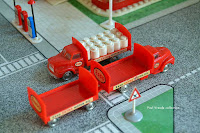The train track is overdoing it a bit to my taste, so I'm contenting myself with just having some contemporary buildings, based on various sources.
The front cover of the town plan shows some buildings that
I've also built. Incidentally, the boy playing with the Esso truck is a young
Kjeld Kirk Kristiansen, the grandson of Lego Founder Ole Kirk Christiansen and
the man who was CEO and Chairman of the company until 2004 (his last name
starts with a K due to a clerical error when he was born apparently).
The back of the townplan shows other buildings, some of
which were available as sets at the time. I've built a few of those to go with
my townplan as well. The iconic Esso service station I initially built from
loose parts, but then I found a glued-together display model at a swapmeet,
made from all the correct parts including the special plates trimmed in red.
Its other disadvantage is that it can (and most often does)
warp over time, making larger bricks completely useless. The white flatbed
trailers made from cellulose acetate are very likely to be twisted into weird
shapes, and most Mercedes convertibles and moving trucks go somewhat
banana-shaped as well.
The Bedford trucks (and passenger cars) were issued in ABS
plastic before the Bedfords were replaced with Mercedes trucks. But for sheer
period nostalgia, the bright shine of cellulose acetate is hard to beat.



















Wonderful, that was a great history, and a great collection of models. Very colourful.
ReplyDeleteWow! Great post, and actually a bit before my time!
ReplyDeleteI thought I was grey whiskered because my Lego bricks only came in red and white with a grey base (anyone else remeber the wheels with grey rubber tyres and brass axles?) but reading this, I see I completely missed out on the Cellulose Acetate Period!
Fascinating reading!
Thanks to both of you for the kind words!
ReplyDeleteOf course I remember those wheels with the grey tires. I have a trio of trucks sitting on a shelf that use them. They're the ones with the steering front wheels from ca 1967 (sets 331, 332 and 335 if you want to google them :)
I myself am actually also too young for cellulose acetate. I think the few CA bricks we had when young were leftovers still in stock at toy stores. We noticed they were different and didn't grip very well but never really wondered why. Building with them takes care and patience, because everything will topple over at the drop of a gnat. :) But they do look fabulous!
Best -- Paul
... and I should point out that half my buildings are made from ABS bricks, esp the larger ones. That hotel (from the suggestions of the US town plan) would be a nightmare to build in cellulose acetate!
ReplyDeleteBest -- Paul
thanks for sharing,i love lego!! :)) EW
ReplyDeleteIncredible vehicles, incredible sets!
ReplyDelete